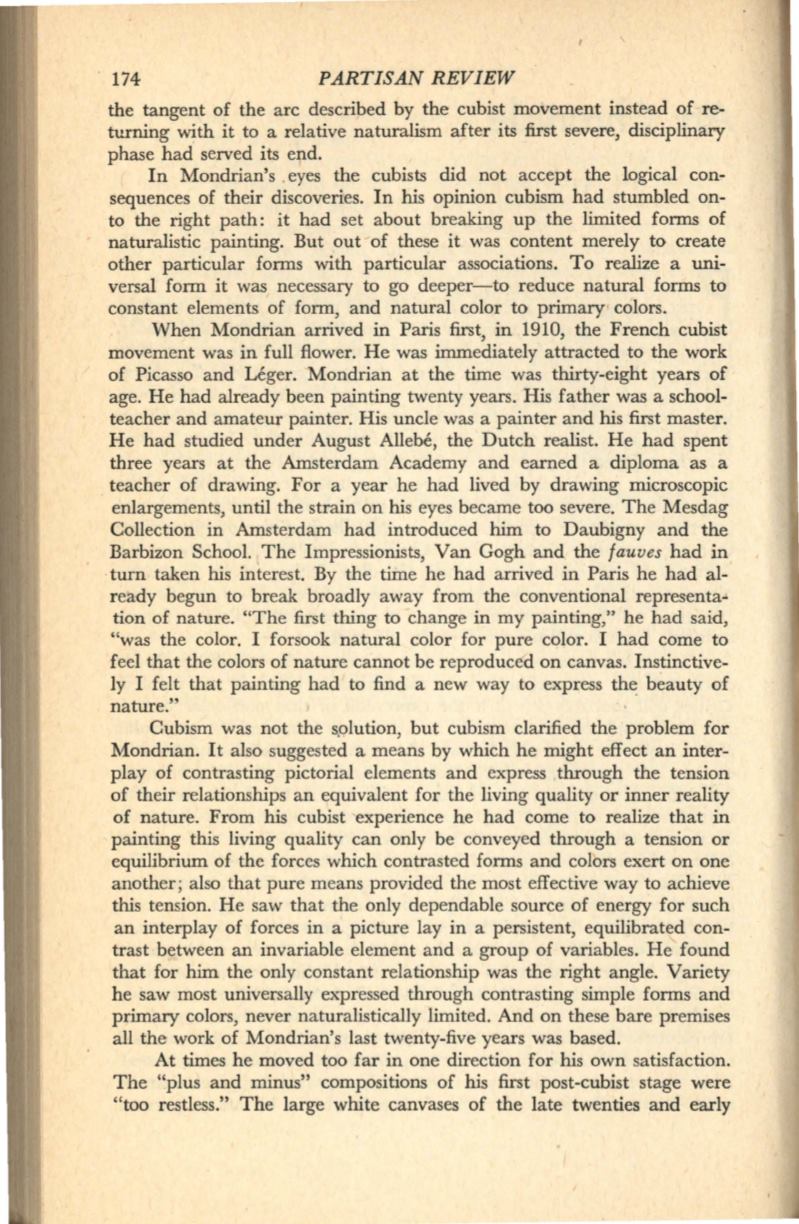
174
PARTISAN REVIEW
the tangent of the arc described by the cubist movement instead of re–
turning with it to a relative naturalism after its first severe, disciplinary
phase had served its end.
In Mondrian's .eyes the cubists did not accept the logical con–
sequences of their discoveries. In his opinion cubism had stumbled on–
to the right path: it had set about breaking up the limited forms of
naturalistic painting. But out of these it was content merely to create
other particular forms with particular associations. To realize a uni–
versal form it was necessary to go deeper-to reduce natural forms to
constant elements of form, and natural color to primary colors.
When Mondrian arrived in Paris first, in 1910, the French cubist
movement was in full flower. He was immediately attracted to the work
of Picasso and Leger. Mondrian at the time was thirty-eight years of
age. He had already been painting twenty years. His father was a school–
teacher and amateur painter. His uncle was a painter and his first master.
He had studied under August Allehe, the Dutch realist. He had spent
three years at the Amsterdam Academy and earned a diploma as a
teacher of drawing. For a year he had lived by drawing microscopic
enlargements, until the strain on his eyes became too severe. The Mesdag
Collection in Amsterdam had introduced
him
to Daubigny and the
Barbizon School. The Impressionists, Van Gogh and the
fauves
had in
turn taken his interest. By the time he had arrived in Paris he had al–
ready begun to break broadly away from the conventional representa–
tion of nature. "The first thing to change in my painting," he had said,
"was the color. I forsook natural color for pure color. I had come to
feel that the colors of nature cannot be reproduced on canvas. Instinctive–
ly I felt that painting had to find a new way to express the beauty of
nature."
·
Cubism was not the s.olution, but cubism clarified the problem for
Mondrian. It also suggested a means by which he might effect an inter–
play of contrasting pictorial elements and express through the tension
of their relationships an equivalent for the living quality or inner reality
of nature. From his cubist experience he had come to realize that
in
painting this living quality can only be conveyed through a tension or
equilibrium of the forces which contrasted forms and colors exert on one
another; also that pure means provided the most effective way to achieve
this tension. He saw that the only dependable source of energy for such
an interplay of forces in a picture lay in a persistent, equilibrated con–
trast between an invariable element and a group of variables. He found
that for him the only constant relationship was the right angle. Variety
he saw most universally expressed through contrasting simple forms and
primary colors, never naturalistically limited. And on these bare premises
all the work of Mondrian's last twenty-five years was based.
At times he moved too far in one direction for his own satisfaction.
The "plus and minus" compositions of his first post-cubist stage were
"too restless." The large white canvases of the late twenties and early


